

Running : ces erreurs qui ruinent tout en rentrant du sport. Manger immédiatement après son jogging Certes, si l'on court directement en quittant le bureau, il est fort possible d'avoir faim quand les baskets sont à l'arrêt.

Mais mieux vaut attendre au minimum quinze minutes avant de manger, pour le cerveau. Le coach sportif William Chanconie explique : « Au même titre qu'en début de course, le corps a besoin d'un petit quart d'heure pour se plonger dans l'effort. Après le running, l'organisme et le cerveau ont aussi besoin de saisir que l'effort est terminé et que la phase de récupération peut commencer. » Attendre trop longtemps pour manger En attendant trop longtemps, vous ruinez littéralement vos efforts.
Ne rien avaler parce que l'on n'a pas faim Après avoir sué sang et eau, il n'est pas rare de passer l'étape alimentation pour filer sous la douche puis sous la couette. 6 Basic Eating Habits for Triathletes. By Matt Dixon In 2015, I spent a lot of time hammering home to purplepatch athletes, pro and amateur alike, that they need to 'get the basics right.' Of course, we discuss and work on many of the finer details of our sport, such as technique, race fueling, strategy, etc.
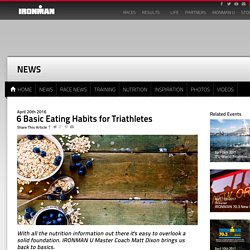
Triathletes Guide to Protein. The Triathlete's Guide to Protein Jan 19, 2016 by Kim Mueller, MS, RD, CSSD In Greek, protein means "to take first place"—a feat more triathletes aspire to.
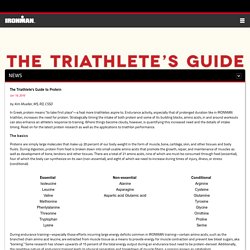
Pro tips: Making a nutrition breakthrough. There’s a reason nutrition is known as the “fourth discipline” of triathlon—what an athlete eats in and out of training directly impacts swim, bike and run performance.
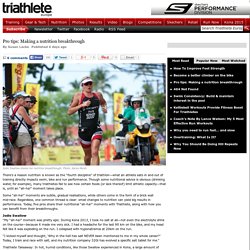
Though some nutritional advice is obvious (drinking water, for example), many triathletes fail to see how certain foods (or lack thereof) limit athletic capacity—that is, until an “ah-ha!” Moment takes place. Some “ah-ha!” Moments are subtle, gradual realisations, while others come in the form of a brick wall mid-race. Regardless, one common thread is clear: small changes to nutrition can yield big results in performance. Jodie Swallow “My “ah-ha!” Racing Weight: Lose Weight Or Lose Fat? When a person says she wants to lose five or 10 pounds, it’s understood that she means five pounds of fat, not five pounds of muscle, bone mass, or body water.
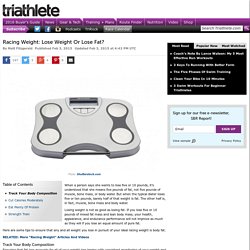
But when the typical dieter loses five or ten pounds, barely half of that weight is fat. The other half is, in fact, muscle, bone mass and body water. Racing Weight: The 8% Rule. 4 Reasons You’re Not Losing Weight. Q: I’m training for an Ironman and I thought I could eat whatever I want, but I’ve gained 5 pounds.
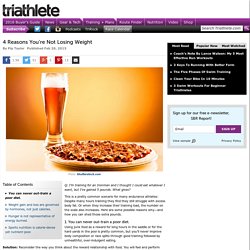
Finding The Ideal Ironman Diet. Q: I am training for my first Ironman.
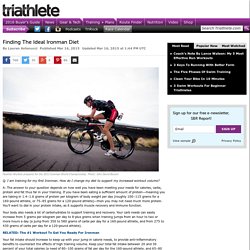
How do I change my diet to support my increased workout volume? A: The answer to your question depends on how well you have been meeting your needs for calories, carbs, protein and fat thus far in your training. If you have been eating a sufficient amount of protein—meaning you are taking in 1.4–1.6 grams of protein per kilogram of body weight per day (roughly 100–115 grams for a 160-pound athlete, or 75–85 grams for a 120-pound athlete)—then you may not need much more protein.
You’ll want to dial in your protein intake, as it supports muscle recovery and immune function. Your body also needs a lot of carbohydrates to support training and recovery. 9 Nutrition Rules For Beginner Triathletes. New to triathlon?
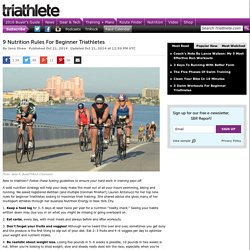
Follow these fueling guidelines to ensure your hard work in training pays off. A solid nutrition strategy will help your body make the most out of all your hours swimming, biking and running. Racing Weight: Lose Weight Or Lose Fat? 5 Foods For Recovery. Three smoothie recipes from British Cycling’s Nigel Mitchell - Recipes - 220Triathlon. Smoothies are a great way to feed the body, and provide all of the nutrients needed for health and vitality.
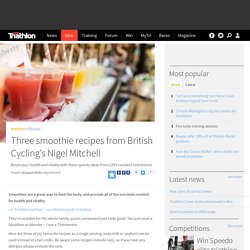
>>> Triathlon nutrition – our ultimate guide to fuelling They’re suitable for the whole family, quick, convenient and taste great. You just need a liquidiser or blender – I use a Thermomix. Here are three of my favourite recipes as a single serving (soya milk or yoghurt can be used instead of cow’s milk). 5 Simple Food Swaps. By Pip Taylor Sports nutrition has evolved over the last few decades from bananas taped on top tubes to a massive industry.
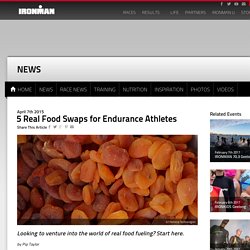
Not long ago these types of new foods were barely in existence; now they seem almost mandatory, and especially for those focused on endurance activities. From energy and electrolyte drinks to gels, bars, chews, recovery shakes and salt tablets, there is truly a product for everyone and every activity. 54 Healthy Smoothies for Any Occasion. 9 steps to better eating.
If you want to be in awesome shape you have to promote nutrition up your priority list. There are way too many people out there striving for physical change and eating trash constantly then wondering why they are not getting the results they want. Insanity. As a short background we have a global issue related to obesity and as a result of that obesity the onset of type 2 diabetes. 27 Foods To Eat At Suhoor That Release Energy Throughout The Day During Ramadan. What Is The Right Balance Of Carbs, Fat And Protein? Steer clear of one-size-fits-all formulas to balance carbs, fat and protein in your diet. Some sports nutrition experts recommend a 60/20/20 diet. What’s that? It’s a diet where you get 60 percent of your daily calories from carbohydrate and 20 percent each from fat and protein. Advocates say endurance athletes need to consistently maintain this ratio of the three so-called “macronutrients” to perform optimally in training.
Other experts recommend a more evenly balanced 40/30/30 diet.
Using Real Foods For Long-Distance Training. Fuel your long-course training and racing with real foods to reap the benefits. Whether you’re sick of manufactured sports nutrition, have never found the right product for you, or you’d just like to be more aware of what goes into your body, consuming real foods might just be the missing ingredient in your long-course racing. Here’s what you need to know. Why should I switch? For one, you would be eating food provided by nature. How To Increase Lean Body Mass.
Lean body mass is a critical component in determining overall fitness. Although exercise represents the cornerstone for increasing lean body mass – which is primarily muscle protein other factors play an important role. Building muscle protein is a dynamic process. At any given moment, our metabolic machinery is involved in manufacturing and repairing new muscle protein while at the same time breaking down existing protein. Understanding this core principle enables you to implement some simple measures to increase lean body mass. What Is The Right Balance Of Carbs, Fat And Protein? Using Real Foods For Long-Distance Training.